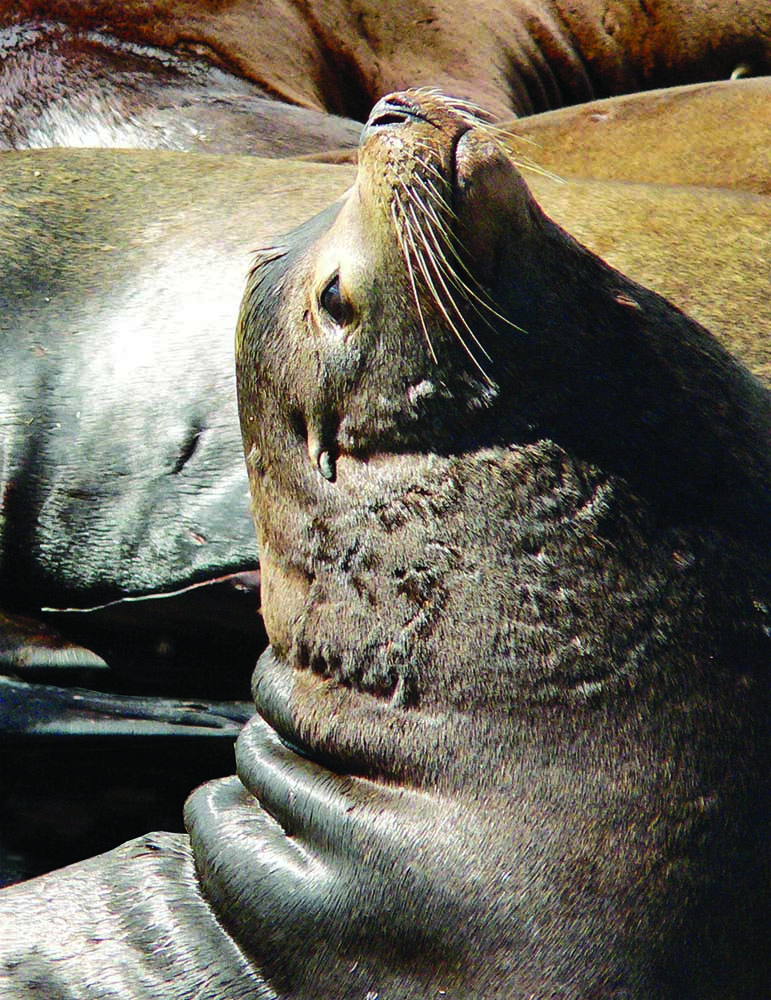Sea lion-salmon predation task force mulls ways to reduce impacts on endangered fish
Published 7:59 am Tuesday, March 7, 2017

- A sea lion basks in the sun along the Lower Columbia River.
PORTLAND — NOAA Fisheries’ Pinniped-Fishery Interactive Task Force met last week for the fifth time since 2008 to review lethal removal of sea lions and hazing operations aimed at reducing salmon predation at Bonneville Dam.
Trending
By all accounts, lethal removal at the dam has not done its job.
The sea lions are still at the dam and continue to arrive. Even when some are removed or killed, the pinnipeds continue to eat wild salmon and steelhead listed as endangered or threatened under the federal Endangered Species Act.
As many as 3,000 California and Steller sea lions are present in the Columbia River from Astoria to Bonneville Dam with three to five sea lions at any one time in the Bonneville pool from January and into June (when the males leave for California breeding grounds).
Trending
The Task Force last week reconvened to consider ways to improve lethal removal and hazing of the sea lions authorized by NOAA Fisheries in a March 15, 2012, Letter of Authorization issued under Section 120 of the Marine Mammal Protection Act (MMPA). The five-year LOA was renewed by a June 28, 2016 LOA.
The authorization allows the states of Oregon, Washington and Idaho to “lethally remove individually identifiable California sea lions that are having a significant negative impact on ESA-listed salmon and steelhead in the vicinity of Bonneville Dam,” according to NOAA Fisheries information announcing the Task Force meeting. The meeting was in Portland March 1 and 2.
Currently, before going through the process of being listed for authorized removal, California sea lions must be present at the dam for five consecutive days, be seen by Corps observers eating salmon, and be subjected to hazing first.
Recommendations to NOAA Fisheries from the Task Force will be ready in the next couple of weeks.
Once the Task Force has completed its deliberations and submitted the recommendations, NOAA will determine a course of action for the sea lion removal program that is informed by the Task Force recommendations, according to Task Force information.
The U.S. Army Corps of Engineers documented in 2016 the second-largest number of California and Steller sea lions since observations and recordkeeping began in 2002 — 190 unique individuals, according to a recent Corps report.
Over the life of the sea lion removal program, 166 California sea lions have been permanently removed. That includes those that were transferred to public display (zoo), euthanized, or accidentally died.
All were considered predatory, had resided and been observed at Bonneville Dam for at least five days, and had been individually marked by branding.
California sea lions killed the largest proportion of spring Chinook salmon and steelhead this year than in any year since 2011, according to information provided by NOAA Fisheries pinniped specialist Robert Anderson.
Some 6,371 salmonids were observed being consumed at the dam by the sea lions — 3.9 percent of a run of 154,074 salmonids that made it to below the dam.
The percentage of fish killed was lower in 2015 when 3.12 percent of a run of 239,326 died, but the actual number of fish killed was higher at 7,779 due to the larger run size.
2014: 219,929 run size, and 2,615 salmonids or 1.17 percent of the run killed by California sea lions.
2013: 120,619 run size, 1,402 killed, 1.14 percent of the run.
2012: 171,665 run size, 998 killed, 0.57 percent of the run.
2011: 223,380 run size, 2,527 killed, 0.11 percent of the run.
Sea lions also consumed Pacific lamprey and white sturgeon.
Task Force members at last week’s meeting were Daryl Boness, scientist; Bruce Buckmaster, Salmon For All; Joyce Casey, Corps; Trevor Conder, NOAA Fisheries; Bob Delong, NOAA Fisheries; Doug Hatch, CRITFC; Chris Hathaway, Lower Columbia Estuary Partnership; Chris Kern, ODFW; John Long, WDFW; Olney “JP” Patt, Confederated Tribes of Warm Springs; Dennis Richey, Oregon Anglers; Carl Scheeler, Confederated Tribes of the Umatilla Indian Reservation; Paul Ward, Yakama Nation; and Sharon Young, Humane Society of the United States.
The Task Force was asked to consider four questions:
(1) Is the current lethal removal program effectively reducing pinniped predation on at-risk salmonids? If not, what changes do you recommend?
(2) Does non-lethal hazing appear to be an effective aid in reducing sea lion predation on salmonids in the area? Should non-lethal efforts be modified (increased, reduced, or re-directed) to improve effectiveness?
(3) Do the criteria in the authorization for identifying predatory sea lions remain appropriate? If not, how could these criteria be modified to improve effectiveness?
(4) Are there other terms and conditions of authorization or aspects of the states’ implementation of the removal activities that limit effectiveness of the permitted lethal removals? If so, what changes are recommended?
Although the Task Force’s recommendations will not be available for a couple of weeks, among the recommendations discussed at the meeting are a consideration of suspending sea lion hazing, with the exception of hazing at the dam’s fish ladders.
While the Corps is responsible for observation, cataloguing and branding sea lions, hazing activities are left up to the Columbia River Inter-Tribal Fish Commission and the states of Oregon and Washington.
When they are being hazed sea lions do not eat fish, but they will quickly return to the dam within as little as 30 minutes to prey on salmon. The Task Force agreed that this is not a successful activity, but suggested preserving hazing at fish ladders, where much of the predation occurs.
All on the Task Force believed the lethal removal program has not eliminated the problem of sea lions eating salmon at the dam. The current program limits lethal removal to 92 California sea lions each year. Just 59 were removed in 2016, but it still was the most successful year to date for the program.
There was some talk among Task Force members of removing some of the barriers that inhibit the program.
One is the five-day limit before a sea lion can be captured, branded and eventually removed. According to recent information, many sea lions don’t stay at the dam that long. In fact, the amount of time they reside at the dam has dropped significantly since 2008 when the maximum residency for an identified individual was 80 days and the mean was 20 days. In 2016, the maximum residency was 23 days, but the mean was just 3 days.
The statute says that to mark a sea lion for removal it must be seen eating “and” have been observed for five days. That could be changed to eating “or” have been observed for three to five days, Daryl Boness suggested.
Hatch of CRITFC argued that a California sea lion should be eligible for the removal program if it is upstream of Bonneville Dam, without any other criteria. Some three to five sea lions are in the 30 mile long pool each day, he said. Not all of those sea lions are branded, but he’s fairly certain that if they are there, they are eating fish.
Hazing in the lower river near Astoria of animals that haul out at docks could reduce the entire population in the river and, as a consequence, the number of sea lions that travel to Bonneville Dam, DeLong of NOAA Fisheries said. He admitted, however, that there is not an obvious connection between the number of sea lions at the dam and any hazing activity that would be done in the lower river.
Still, he recommend that “NOAA work with Astoria to discourage those animals. It’s possible that could go a long way to solving our problem of the increasing number of animals in the upper river.









